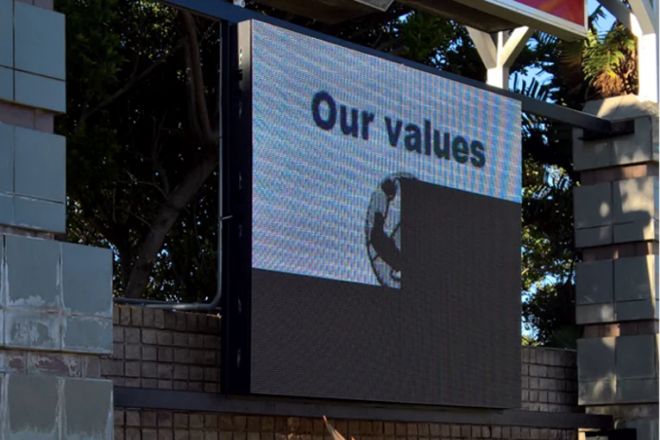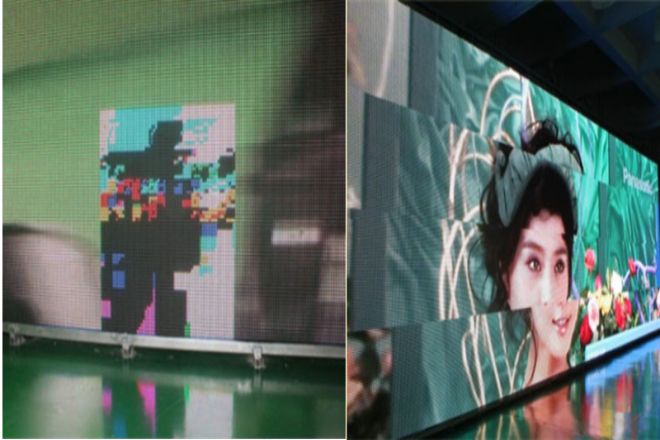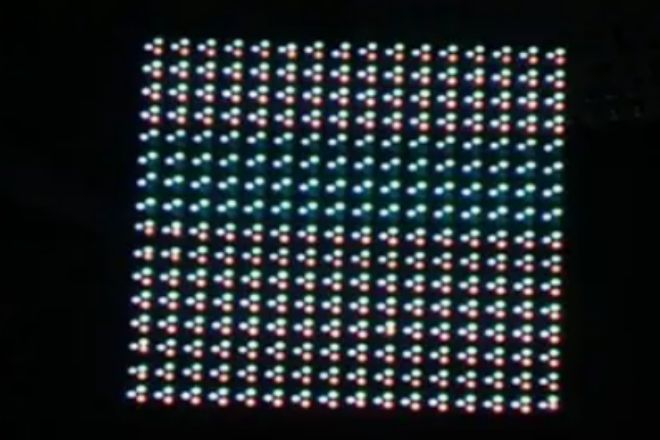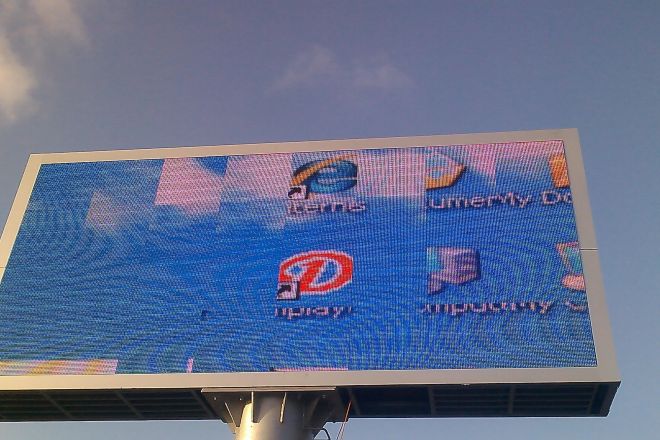Introduction

With the rapid development of science and technology, LED display screens have been widely used in many fields, such as advertising, information release, and stage performances, due to their high brightness, bright colors, and low power consumption.
However, like any electronic device, LED displays will inevitably experience various failures during long-term use. These failures will not only affect the normal use of the display but may also have a negative impact on the brand image and user experience.
Therefore, understanding the troubleshooting strategies of LED displays is of great significance to ensure the stable operation of the equipment.
1. Common types and causes of LED display failures

- Electricity failure:
Power failure of an LED display is one of the common reasons why it fails to work properly, or its performance degrades. An unstable power supply may be caused by factors such as grid voltage fluctuations, aging or damage of power equipment, poor contact of power lines, etc. When the power supply is unstable, the display may have uneven brightness, flicker, or even fail to light up at all.
In addition, damage to the power line is also one of the common power failures, which may be caused by aging of the line, short circuit, open circuit, etc. Damage to the power line will prevent the display from receiving a stable power supply, thus affecting its normal operation.
- Control system failure:
The control system is the brain of the LED display, which is responsible for receiving signals, analyzing data, and controlling the display content. A control system failure may cause the display to fail to display content correctly or display abnormally.
Common control system failures include control system software crashes, control card damage, etc. Software crashes may be caused by software design flaws, virus attacks, insufficient system resources, etc., while control card damage may be caused by long-term work, overheating, aging, etc.
When the control system fails, the display may have confusing display content, blurry screen, black screen, etc.
- Display module failure:
The display module is the core part of the LED display and is responsible for displaying images and text. Failure of the display module may cause partial or overall display abnormalities. Common display module failures include LED lamp bead damage, module circuit problems, module connection problems, etc. LED lamp bead damage may be caused by overpowering, aging, quality problems, etc.
Module circuit problems may be caused by circuit aging, poor contact, short circuits, etc. Module connection problems may be caused by loose connectors, damage, and other reasons. When the display module fails, the display may have a partial black screen, bright spots, dark spots, uneven display, etc.
- Environmental factor:
Environmental factors also have a great impact on the normal operation of LED displays. Environmental factors such as high temperature, moisture, dust, etc., may cause display failure. High-temperature environments can cause the internal components of the display to overheat, affecting its performance and lifespan.
A humid environment may cause corrosion of the internal components of the display, affecting circuit connections and stability. Dust accumulation may affect the heat dissipation and display effect of the display and even cause short circuits and other failures. Therefore, when installing and using LED displays, you need to pay attention to the impact of environmental factors and take corresponding protective measures.
- Human Factors:
Human factors are also one of the common causes of LED display failure. Misoperations such as incorrect parameter settings, improper operations, etc., may cause abnormalities on the display screen.
For example, mistakenly adjusting the brightness too high may cause the LED lamp beads to age too quickly; mistakenly changing the control system parameters may cause confusion in the display content. In addition, external impact is also one of the common failures caused by human factors.
Accidental impact may cause damage or deformation of the display’s internal structure, thereby affecting its normal operation. Therefore, when using and maintaining LED displays, you need to follow correct operating procedures and precautions to avoid failures caused by human factors.
2. Preventive measures for LED display failure
In order to ensure the long-term stable operation of the LED display and reduce the possibility of failure, we need to take a series of preventive measures. The following are some suggestions for LED display failure prevention:
- Check the power supply regularly to ensure stable power supply:
The power supply is the basis for the normal operation of LED displays. Unstable power supply will directly affect the performance and life of the display. Therefore, it is important to check the power supply regularly.
This includes checking whether the power line is intact, whether the power socket is in good contact, whether the power voltage is stable, etc.
If the power supply equipment is aged or damaged, it should be replaced in time to ensure a stable supply of power.
- Regularly update control system software and back up important data:
The control system is the brain of the LED display, responsible for receiving signals, analyzing data and controlling the display content of the display. Therefore, keeping control system software updated and data secure is an important measure to prevent failures.
Regularly updating control system software can fix known software flaws, improve system performance, and enhance security. At the same time, backing up important data can prevent data loss and ensure quick recovery in the event of a software crash or system reset.
- Clean the display screen regularly and keep the environment dry and clean:
The display effect and lifespan of LED display screens are greatly affected by the environment. Pollutants such as dust and dirt will reduce the brightness and contrast of the display and affect the display effect. At the same time, a humid environment may cause corrosion of the internal components of the display, affecting circuit connections and stability.
Therefore, regular cleaning of the display screen and keeping the environment dry and clean are important measures to prevent failures. When cleaning, use special detergent and soft cloth to avoid using chemical solvents or hard objects to scratch the display surface.
- Strengthen employee training to reduce failures caused by human factors:
Human factors are one of the common causes of LED display failure. Misoperation, external impact, etc., may cause the display to malfunction. Therefore, strengthening employee training and improving employees’ understanding and skills in display operation and maintenance are important measures to prevent failures.
Through training, employees can understand the working principle, operation methods, and maintenance requirements of the display screen and master the correct operating procedures and precautions, thereby avoiding failures caused by human factors.
- Establish a complete maintenance system to ensure that the display screen is in good condition for a long time:
Establishing a complete maintenance system is an effective long-term measure to prevent LED display failures. The maintenance system should include regular inspection, cleaning, replacement of worn parts, calibration, etc.
Through regular maintenance of the display screen, potential problems can be discovered and dealt with in time, ensuring that the display screen is in good condition for a long time.
At the same time, the maintenance system can also record the usage and maintenance history of the display screen, providing an important basis for subsequent fault analysis and processing.
3. Diagnosis and troubleshooting of LED display faults

When the LED display fails, we need to follow certain steps to diagnose and troubleshoot to determine the specific cause of the failure and take corresponding solutions. The following are the steps for diagnosing and troubleshooting LED display failures:
1). Observation and analysis of fault phenomena:
Record the fault phenomenon in detail, including the display status of the display, abnormal sounds, smells, etc.
Preliminarily determine the type of fault, such as power supply failure, control system failure, display module failure, etc.
2). Power check:
Use a multimeter and other tools to check the power line and confirm whether the power line is intact and the contact is good.
Check the power supply equipment, such as the switching power supply, UPS, etc., to confirm whether it is working properly and whether the output voltage is stable.
If there is a problem with the power line or power supply equipment, it should be replaced or repaired in time.
3). Control system check:
Check whether the control system software is running normally and whether there are software crashes, data loss, etc.
Check whether the control card is damaged or loose. If necessary, replace the control card or reinsert it tightly.
Check the connection between the control system and other devices, such as serial port cables, network cables, etc., to ensure that the connections are normal.
4). Display module check:
Check the LED lamp beads one by one to confirm whether there is any damage or aging. If necessary, replace the lamp beads.
Check the module circuit to confirm whether the circuit is intact and the connection is tight. If there is any damage or aging, replace or repair it in time.
Check the module connections to ensure that the connections between modules are tight and stable. If there is any looseness or damage, replace or repair it in time.
5). Exclude environmental factors:
Check whether the environment where the display is located meets the requirements, such as temperature, humidity, dust, etc.
If it is found that environmental factors do not meet the requirements, timely measures should be taken to improve the environment, such as adding heat dissipation equipment and strengthening dust prevention measures.
In the process of diagnosing and troubleshooting LED display faults, it is necessary to observe and inspect them patiently and carefully, as well as investigate possible causes of faults one by one. At the same time, certain professional knowledge and skills are also required in order to more accurately determine the cause of the failure and take effective solutions.
If you cannot solve the fault yourself, it is recommended that you contact professional LED display maintenance personnel for repair.
4. Repair and replacement of LED display failures
After diagnosing and troubleshooting the LED display fault, we need to repair or replace it according to the type of fault. Here are the detailed steps and precautions:
- Choose the appropriate repair method:
Depending on the type of fault, select the corresponding repair method. If the power line fails, you may need to replace the power line or repair the wiring terminals; if the control system software fails, you may need to reinstall or update the software; if the driver board fails, you may need to replace the driver board, etc.
Before proceeding with repair, make sure you have backed up important data and configuration files to prevent data loss.
- Replace faulty parts:
Faulty parts that cannot be repaired, such as damaged LED lamp beads, modules, etc., need to be replaced.
When replacing parts, be sure to choose specifications and models that match the original parts to ensure the performance and stability of the display.
When replacing parts, pay attention to the operating specifications to avoid secondary damage to the display.
- Reassembly and testing:
After replacing the faulty parts, reassemble the display according to the display assembly steps.
During the reassembly process, pay attention to the connection and fixation between components to ensure the stability and safety of the display.
After assembly is completed, functional testing is performed. Testing includes display testing, brightness testing, color testing, etc., to ensure that the display returns to normal operation and that all performance parameters meet standards.
- Precautions:
When carrying out repair and replacement work, be sure to cut off the power supply to ensure your own safety.
Use professional tools and equipment to avoid unnecessary damage to the display.
During operation, pay attention to anti-static and dust-proof to prevent damage to the display screen caused by static electricity and dust.
After the repair is completed, conduct a comprehensive inspection of the display to ensure that there are no missed fault points.
Through the above steps, we can effectively repair and replace the faulty parts of the LED display to ensure that the display returns to normal operation. At the same time, in daily use, you also need to pay attention to regular maintenance and upkeep of the display screen to extend its service life and improve stability.
5. Precautions for LED display troubleshooting

When dealing with LED display failure, there are some important precautions that need to be followed in order to ensure the smooth progress of the work and avoid potential risks. The following are specific precautions for troubleshooting LED display screens:
- Safety first:
Before dealing with any malfunction, first, ensure your safety and that of your surroundings. Turn off the power to prevent the risk of electric shock.
Use appropriate tools and protective equipment, such as insulating gloves, goggles, etc., to prevent accidents.
- Backup data:
Before replacing, updating, or repairing control system software or control cards, be sure to back up important data and configuration files.
Data backups should be stored in a safe and secure location so that they can be restored quickly if needed.
- Choose the appropriate repair method:
Depending on the type and cause of the fault, choose the most appropriate repair method. The wrong repair method can lead to more severe damage or greater losses.
If you are not sure how to fix it, you should consult a professional technician or seek help from a professional repair service.
- Record the troubleshooting process:
When handling a fault, information such as the fault phenomenon, processing steps, replaced parts, and repair results should be recorded in detail.
Troubleshooting records have important reference value for future troubleshooting and maintenance and can help quickly locate and solve similar problems.
- Follow operating procedures:
When dealing with faults, you should follow the operating procedures and maintenance manual of the LED display to ensure correct and standardized operation.
Avoid dismantling, changing, or adjusting the components and parameters of the display at will to avoid unnecessary losses or risks.
- Prevent secondary failures:
After the fault is repaired, comprehensive testing and inspection should be carried out to ensure that the display returns to normal operation and to eliminate potential problems.
Regularly check and maintain the power supply, control system, display module, and other components of the display screen, discover and deal with potential problems in a timely manner, and prevent secondary failures.
By following the above precautions, LED display failures can be handled more effectively, ensuring the stable operation of the display and extending its service life.
Conclusion
LED display troubleshooting is a complex and meticulous process, which requires us to strengthen prevention and monitoring in daily use and maintenance, and to discover and solve potential problems in a timely manner. At the same time, when facing specific faults, we need to choose appropriate processing methods according to the type of fault to ensure that the fault can be solved in a timely and effective manner.
Finally, if you want to know more about LED displays, please get in touch with us.
